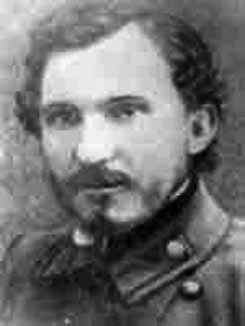Biography:Mikhail Suslin
Mikhail Y. Suslin | |
|---|---|
 | |
| Born | Krasavka, Saratov Oblast |
| Died | 21 October 1919 (aged 24) Krasavka, Saratov Oblast |
| Scientific career | |
| Fields | General topology, descriptive set theory |
Mikhail Yakovlevich Suslin (Russian: Михаи́л Я́ковлевич Су́слин; , November 15, 1894 – 21 October 1919, Krasavka) (sometimes transliterated Souslin) was a Russian mathematician who made major contributions to the fields of general topology and descriptive set theory.
Biography
Mikhail Suslin was born on November 15, 1894, in the village of Krasavka, the only child of poor peasants Yakov Gavrilovich and Matrena Vasil'evna Suslin.[1] From a young age, Suslin showed a keen interest in mathematics and was encouraged to continue his education by his primary school teacher, Vera Andreevna Teplogorskaya-Smirnova. From 1905 to 1913 he attended Balashov boys' grammar school.[2]
In 1913, Suslin enrolled at the Imperial Moscow University and studied under the tutelage of Nikolai Luzin.[1] He graduated with a degree in mathematics in 1917 and immediately began working at the Ivanovo-Voznesensk Polytechnic Institute.[2]
Suslin died of typhus in the 1919 Moscow epidemic following the Russian Civil War, at the age of 24.
Work
His name is especially associated to Suslin's problem, a question relating to totally ordered sets that was eventually found to be independent of the standard system of set-theoretic axioms, ZFC.
He contributed greatly to the theory of analytic sets, sometimes called after him, a kind of a set of reals that is definable via trees. In fact, while he was a research student of Nikolai Luzin (in 1917) he found an error in an argument of Lebesgue, who believed he had proved that for any Borel set in [math]\displaystyle{ \R^2 }[/math], the projection onto the real axis was also a Borel set.
Publications
Suslin only published one paper during his life: a 4-page note.
- Souslin, M. Ya. (1917), "Sur une définition des ensembles mesurables B sans nombres transfinis", C. R. Acad. Sci. Paris 164: 88–91
- Souslin, M. (1920), "Problème 3", Fundamenta Mathematicae 1: 223, doi:10.4064/fm-1-1-223-224, http://matwbn.icm.edu.pl/ksiazki/fm/fm1/fm1125.pdf
- Souslin, M. Ya. (1923), Kuratowski, C., ed., "Sur un corps dénombrable de nombres réels" (in French), Fundamenta Mathematicae 4: 311–315, doi:10.4064/fm-4-1-311-315, http://pldml.icm.edu.pl/pldml/element/bwmeta1.element.bwnjournal-article-fmv4i1p24bwm?q=bwmeta1.element.bwnjournal-number-fm-1923-4-1;23&qt=CHILDREN-STATELESS
See also
References
- ↑ 1.0 1.1 O'Connor, John J.; Robertson, Edmund F. (March 2011). "Mikhail Yakovlevich Suslin". MacTutor History of Mathematics Archive. University of St Andrews. https://mathshistory.st-andrews.ac.uk/Biographies/Suslin/.
- ↑ 2.0 2.1 Igoshin, V. I. (1996). "A short biography of Mikhail Yakovlevich Suslin". Russ. Math. Surv. 51 (3): 371–383. doi:10.1070/RM1996v051n03ABEH002905. Bibcode: 1996RuMaS..51..371I. https://iopscience.iop.org/article/10.1070/RM1996v051n03ABEH002905.
External links
 |

